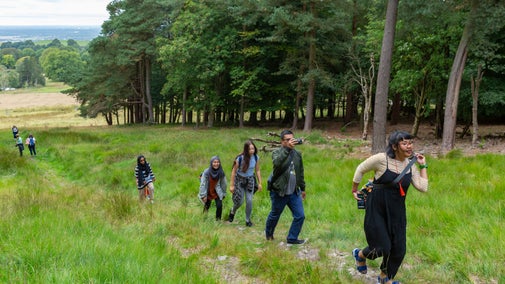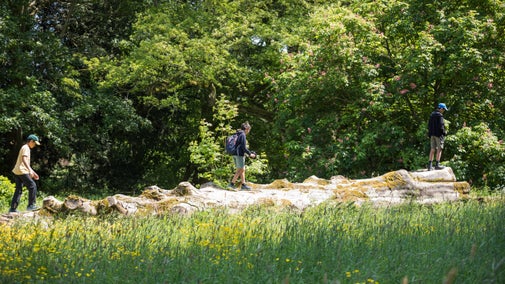
Discover more at Bath Skyline
Find out when Bath Skyline is open, how to get here, the things to see and do and more.

Discover an Iron Age hillfort, 18th-century follies, hidden valleys, tranquil woodlands and meadows, all with plenty of flora and fauna along the Bath Skyline. We care for 500 acres of countryside along the Skyline. There's so much to see, you may worry you’ll miss some of the best parts. We’ve put together some things to see as you explore the Bath Skyline and Little Solsbury Hill.
Autumn on the Bath Skyline brings many changes. The views are fringed with bright splashes of colour, and the beech woodlands turn golden. Animals are preparing for winter, and fungi pop up to reveal a whole host of interesting shapes and colours.
The woodland areas on the Bath Skyline offer fantastic displays of colour. Beech is a particularly colourful autumn tree, and can be found across the Skyline. Views from Bathwick Fields in particular offer far reaching views across the city of Bath and beyond with many shades of gold, brown and green.
Keep your eyes peeled for various different fungi that thrive in the autumn. There are many to be spotted, from large bracket fungus to tiny ink caps.

The Bath Skyline sits on limestone, and the pH neutral calcareous soils that have developed on the underlying rocks encourage certain species of plants. Trees such as ash, hazel, hawthorn, blackthorn, yew, cherry, elder, holly, spindle and field maple trees dominate the younger pioneer wooded areas.
In the older woods, oak, lime, hornbeam, wayfaring tree, wych elm, beech and copper beech can be found as well as horse chestnut and sycamore and the pioneer trees associated with limestone woodland.
After the climb up through Sham Castle Down a short diversion leads you up a narrow path to Sham Castle. A great place to rest your feet and stop for a picnic whilst enjoying the view out across the city of Bath.
Heading into Bathwick woods, you’ll pass woodland glades, created to improve the diversity of wildlife habitat. This area underwent extensive quarrying, possibly back in Roman times. Bathwick Wood has an intriguing mix of mature statuesque beeches, planted, with self-seeded ash and sycamore woods to explore.
From the open pasture of Bathampton Down you’ll be able to look out towards Little Solsbury Hill, Bathampton, Batheaston, and up into the Swainswick valley and the Cotswolds beyond.
Away from the main Bath Skyline walk to the north east of Bath and above the village of Batheaston, Little Solsbury Hill offers views across the surrounding countryside and back to Bath itself. It’s the site of an Iron Age hillfort and was the inspiration for Peter Gabriel’s song Solsbury Hill. The hill’s made up of mudstone and oolitic limestone.
After leaving Bathampton Down you pass through Bathampton Woods. Halfway through the wood on the Skyline path, you cross the remains of an incline railway that used to transport quarried stone to the bottom of the hill in gravity powered trucks. You'll see that most of the buildings in the city below have been built with Bath stone from the area.

Mature oak, field maple and ash trees can be seen in this area, their appearance being of park-like trees scattered about the pasture. These trees were originally woodland trees, indicated by their shape and the name Bushey Norwood.
Claverton Down is the plateau above the steep slopes of Bathwick. From the top you can enjoy panoramic city views of Bath and the green spaces beyond as you walk along part of an 18th century carriage drive, known as the Balcony. Prior Park Landscape Garden is tucked away in the valley below.
Rainbow Wood Farm covers much of Claverton Down. Look out for cattle and sheep grazing and young lambs playing in the fields.
Rainbow Wood Fields lie between the Skyline path and Prior Park. Rainbow Wood sits above the fields and gets its colourful name from the arc shape of the woodland.
The Skyline around Claverton Down is home to many mature beech trees, likely planted, with some still showing their origins as avenue trees from an 18th-century deer park estate. These trees are often large, and beautiful with their clean silvery bark.
For the young, and the young at heart, why not stop off in the woodland play area? There’s lots of space to explore, dens to build, logs to balance on a winding woodland walk. There’s also a picnic area for lunchtime. You’ll find the woodland play area at point 8 on the Bath Skyline walk.
In Smallcombe Vale you’ll pass through two traditional hay meadows. A short diversion off the Skyline path will take you to Smallcombe Woods with Smallcombe Garden Cemetery (not National Trust) nestled in the vale below the wood. Smallcombe Wood is Bath’s only ancient woodland, having been here for at least 400 years. Discover veteran oak, lime and ash trees along the network of informal paths.
Wide open fields within a kilometer of Bath Abbey, with great views over the city and beyond. Nestled in the middle of these fields you’ll find Richens Orchard – created in 2005 after a local donation of trees. You'll find many varieties here including apple, pear and plum. The orchard is open for much of the year but closes only while sheep graze in the autumn.

Find out when Bath Skyline is open, how to get here, the things to see and do and more.
Explore some of the finest landscapes in our care on coastal paths, accessible trails, woodland walks and everything in between. Find the best places to walk near you.

From springheads and stone markers to Iron Age field systems, discover more about the Archaeological finds found under the National Trust’s Bath Skyline.

Discover spectacular views of the surrounding countryside and long walks for dogs and owners, no matter what the season. Find out more to help you enjoy your visit.

Plan a visit to one of the special countryside places in our care and discover the benefits of being in the great outdoors. Pack your walking boots and get ready to explore woodlands, valleys and rivers.

Magnificent houses, peaceful gardens, wooded trails and little-known treasures are just some of the wonders to discover in the Bath and Bristol area. Plan your day out and find lots of things to see and do with all the family.
